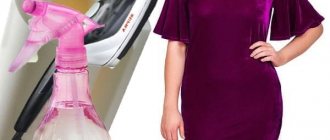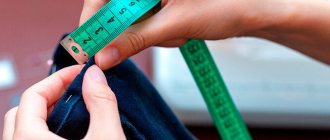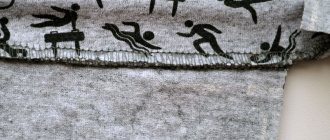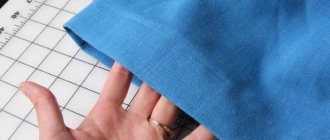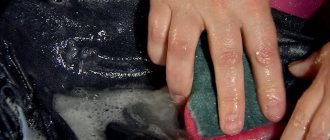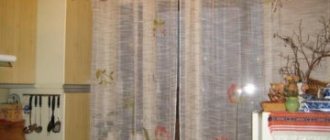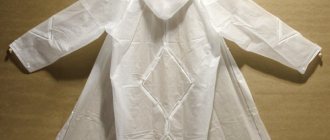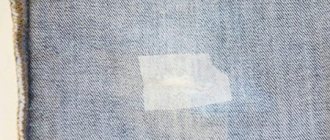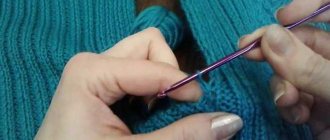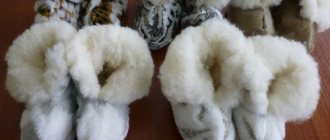Hemming the bottom of trousers or skirts made of thick fabrics can be done on a sewing machine using a special foot. However, it should be taken into account that a hidden seam made on a sewing machine will be invisible only if the fabric of the product is thick enough and loose. Ideally, it is advisable to use this method when hemming the bottom of a skirt made of thick woolen fabric.
What is a blind seam
The answer is hidden in the name itself. A blind seam, when performed using different methods, allows you to connect two parts so that the stitching is not noticeable from the face. Please note that they are usually passed through from the front. A hidden seam helps to finely and exquisitely hem clothes, finish edges, and carefully create children's toys and products with filling.
For this manual work you will need the following materials:
- the product itself or the fabrics that need to be sewn together;
- threads in color;
- needles;
- pins;
- scissors.
It is important to understand that the secret method is performed in 1 thread. Also the key point is the exact selection of threads to the color of the fabric. The line should not be highlighted, otherwise the method will no longer be hidden.
Have you already sewn with a blind stitch?
Yes.
32.35%
No.
67.65%
Voted: 34
Repair of soft toys
When making soft plush toys, using hidden stitching can be considered an excellent find. After all, every mother has faced such a problem at least once.
Stages of work:
- a needle with a thread and a knot must be inserted into the place where the fabric is folded, trying to hide the thread knot;
- unfold the needle and, grabbing several threads of fabric, tighten the fold;
- insert the needle again from the side where the stitching begins. Grab the threads of the fabric again and remove the needle, pulling it forward;
- Having finished the work, fasten the thread and trim off the excess ends with scissors.
In addition, you need to know that there are several types of seams that are made by hand. You should take a closer look at them.
Kinds
There are two main methods of blind stitching, but they are similar to each other.
Both types of blind stitch are essential to completing any sewing project, from clothing to accessories, toys to home decor.
Purl
The first is used when hemming the edges of skirts, trousers, thin jackets and other products. The cut edges are folded to the wrong side, and the thread is passed into the folds of the parts. The stitches on both sides are the same width. Using this method it is possible to sew a drawstring and insert an elastic band. For example, to reduce the width of a dress.
Creating a hemming method is as follows:
- Fold the excess fabric to the wrong side 1 or 2 times.
- Inserting a needle and thread in the color of the material, tying a knot.
- Inserting the needle under the folded fabric.
- The stitch is 60-80 millimeters and the output is through the edge of the fold.
- Picking up 1-3 threads on the fabric to which the hem is sewn.
- Inserting the needle into the fold and into the place where the threads came out.
- Stitch the same length.
- Repeat step 5.
- Stitch the same length.
It is important not to pull the thread too hard, otherwise the material will wrinkle and look pulled together.
Facial
The second method, often known as ladder or herringbone stitch, is good for embroidering on stuffed animals or other items that need to be joined on the right side of the fabric. American needlewomen call the front seam “overlapping”, that is, “whip stitch”.
Here the seams are even, but completely hidden. Stitches vary in width.
Creating a ladder joint consists of three main steps:
- Inserting the needle into the material from below the hole and withdrawing it after a couple of millimeters. Next you need to take a step forward.
- Inserting the needle from the second side of the slot directly above the exit of the needle, namely perpendicular to the first stitch. Again it is necessary to perform the “forward needle” movement and move the tool to the outer part.
- Pulling up the thread. One seam must be pressed against the second so that the stitching is not visible.
Classification of machine seams and their purpose
Working on a sewing machine, having mastered some of the intricacies, will not be difficult even for a beginner. And with new technologies, such work can bring real pleasure. New machines do not tangle or break threads, unlike their older relatives. The fabric is advanced onto them automatically, and the program includes all the main types of seams.
Typically, machine seams are used for sewing clothes, bed linen, curtains and other interior items. In a word, they are relevant wherever you need to sew a lot and for a long time. The classification includes several types of machine seams, and each of them is used for a specific purpose.
Before you start, make sure that the sewing machine foot is securely fastened, otherwise you risk ruining the product.
Stitch seam
The stitch seam is used to connect the main parts of clothing. To make a stitched seam, you need to fold the parts to be sewn with the right side inward. Then pin them together along the future seam line. After this, we sweep away the parts, removing the pins as we go. Now you can proceed directly to making the stitch seam. Along the edges of the work, it is necessary to make fastenings. To do this, you need to make several stitches with a reverse seam. Remember that the smaller the stitches, the stronger the seam itself will be. The presser foot should pass an average of 0.5 - 1.5 cm from the edge of the fabric.
After the stitched seam is completed, it is necessary to iron it. You can do this in several ways:
- stitched seam “pressed” - the edges of both parts are folded in one direction, ironed and stitched together using an overlocker;
- pressed seam “unpressed” - the edges of the parts are bent in different directions and ironed. We sew each edge separately;
- stitched seam “on edge” - the edges of the parts and they themselves are located in the same plane. Sew both edges using an overlocker.
Stitch seam "Ironed"
Stitch seam "Urzutuzhku"
Stitch seam “On edge”
Where is it used (table)
| Usage | Seam type |
| Repairing clothing (e.g. sewing up rips, rips, cuts, discrepancies) | Connecting from the face |
| Creation of plush and other toys (sewing parts of paws, faces, heads, noses, tails) | Connecting from the face |
| Hemming the bottom of products (pants, skirts, sundresses, tops, etc.) | Purl hem |
| Garment processing (sewing sleeves, linings) | Connecting from the face |
| Production of works in the style of patchwork and quilling (folding edges, processing decorative parts) | Purl hem |
How to choose a thread and needle for a blind stitch
There are special monolithic options with the purpose “for hidden seams”. Despite this, any strong and not very thick threads that match the color of the fabric are suitable for working with hidden equipment. It is also important to choose reels based on the material:
- All polyester or nylon. They are distinguished by good twisting, due to which they have less “fuzz”. The stitching is smooth and beautiful.
- Polyester staple. They have good elasticity. Suitable for working with knitted fabrics.
- Bobbins. These threads are strong, thin, and elastic. They serve for a long time.
- Polyamide or nylon. Used when working with genuine leather. High strength, elastic.
- Silk. Very beautiful. Medium strength. Used for machine embroidery, working with thin fabrics and handicrafts.
Preparing to sew
When working with the technique of creating a hidden stitch, people put extra strain on their eyes. The technique requires concentration and a lot of free time. It is also necessary to hold the clothing, toy or other item without changing position, otherwise the vertical seam will turn out crooked and visible.
Therefore, you need to start preparing by choosing a comfortable place with good bright lighting. A practical choice is a table with a lamp. This can help preserve vision and posture. However, sitting on a hard chair for a long time is uncomfortable. Then try to set up a work area on a sofa, armchair or sofa next to the lamps.
Organize your “sewing area” so that you can always reach the tools: pins, threads, scissors, chalk.
Install lighting to your left. It is important that the rays hit the entire workspace. It is advisable not to rely on sunlight - it tires the eyes. The ideal option is a convenient combination of artificial and natural lighting.
How to secure thread at the end of a seam
You can secure the thread at the end of the seam using 2 methods: a knot or a tack. To get the first method:
- Sew a small stitch on the wrong side above the last stitch.
- Slowly tighten the thread.
- After a small ring appears, stand up.
- Pass the needle through the loop.
- Tighten until a new ring appears.
- Insert the needle through the second loop.
- Pull the thread tightly until a knot is formed.
To sew the tack, sew 2-3 small stitches using the backstitch technique. This seam is located on top of another and perfectly connects the layers of material.
Step-by-step instructions for making invisible seams by hand
Using simple technology, you can easily and quickly sew, change or repair clothes, toys and other products. A blind seam using your hands is done according to the same principle. However, some points, nuances and changes relate to the place where the secret technique is used.
Hem your trousers
Often, after buying pants, people encounter one problem - the product is too long, but otherwise it fits perfectly. There is a solution: sewing trousers with a hidden stitch is as easy as shelling pears.
Before you start, you need to try on your purchase and bend the edge so that the fold point is the desired changed length. In this case, the leg should be straight, not bent. Use soap or chalk to mark a dotted line along the fold. Already at the workplace, draw a straight line along the entire perimeter of the trouser leg, using a ruler.
If the owner of the item is not at hand, then simply take his trousers that are suitable in length and measure their length.
Next, draw another line over the bottom seam. It should be about a couple of centimeters above the bottom. Cut this piece in a circle (that is, you only need to cut one layer of fabric, not two).
Now fold the bottom first in one layer so that the edge reaches the top marked line. It is important to fold the fabric to the inside so that the final result looks neat. Secure with pins on the front side. Fold along the fold line again to the desired length. Re-secure with pins.
Then make a hand stitch using a thin needle and thread in the following color:
- Insert the needle into the fold of the fabric from one part so that the knot is “hidden”.
- Insert the tool into the material from the opposite side. Try to get as close as possible to the area through which the tool was just removed.
- Pull the needle into the inside and after a couple of millimeters bring it out through the fold.
- Repeat until you reach the beginning of the line.
Do not over-tighten the thread, otherwise part of the seam will be pulled on the outside.
Fold the edges of jeans
This method of hemming jeans is distinguished by maintaining the factory bottom seam. Additionally, the method is great for fast-growing children, as unraveling the hand stitching is easy.
- Fold the jeans outward to the desired length.
- Next, take a needle and thread and sew a classic seam or a goat stitch along the entire leg. The stitch length is no more than 1-1.5 centimeters. The shorter, the more reliable.
- Now go a second time down a couple of millimeters, trying to fill in the empty spaces.
- Turn out and iron.
How to make an invisible vertical seam with knitting needles: diagram, description
All items that are knitted using a pattern are made in separate parts. Related parts must be assembled into a finished product. You also need to close the hinges so that it looks neat. To sew parts along the edges of the fabric, they most often resort to a vertical seam. It is advisable to do this using the same thread with which you knitted the product, or one very similar in color and structure. The most important thing is that it is durable.
A mattress seam is a type of vertical, invisible seam used to connect the parts of one product. Here is a diagram with a photo and description of how to make the seam.
Making an inconspicuous vertical seam with knitting needles
- To ensure that the seam is not visible, you need to sew from the front side of the product, starting from the bottom edge.
- On the right piece, use a needle to catch the thread between the edge and right loops.
Making an inconspicuous vertical seam with knitting needles
- On the left - between the edge and the last loop of the knitted edge.
- Then continue these manipulations one by one, grabbing the loops, then the broach from one part, then from the other.
Making an inconspicuous vertical seam with knitting needles
- Try not to skip rows, the only exception being parts that are connected with an end-to-end pattern, then you can do it in every second row.
Making an inconspicuous vertical seam with knitting needles
- Do not forget to tighten the thread every 2-3 centimeters so that the stitches are not visible.
Tip: Do not pull them too tightly, as the seam should remain elastic.
If you follow these instructions, you will end up with a perfect seam that will be almost invisible.
Blind stitch on a sewing machine
The special magic foot for secret stitching has a stopper whose position can be adjusted with a screw. There is a twin sister – a model with a “visor”.
As a rule, stitches with a single projection (straight - zigzag - straight) are used for invisible techniques. Suitable for all types of fabric. Options in which a straight line is replaced by a small zigzag are used when working with knitwear.
The further the puncture, the more noticeable the treatment looks from the front side. Therefore, you can first try the technique on a scrap piece of fabric, adjusting the settings.
When preparing to work, iron the hem and turn it over so that only the overcast edge remains.
Then just stitch along the edge.
The trouser tape should protrude 0.1-0.2
I would like to draw your attention to one more nuance. To prevent the trousers from fraying in the fold of the hem, the trouser tape should protrude from the edge of the hem by 0.1-0.2. It's about the same as in this photo.
To make this operation easier, mark with chalk a line to which you will apply the edge of the tape when stitching. It is not necessary to stitch along the tape at 0.1-0.2. Only a professional seamstress can have such precision. You can stitch at 0.4-0.5, and then use an iron to “lay out” the hem exactly at 0.1-0.2.
